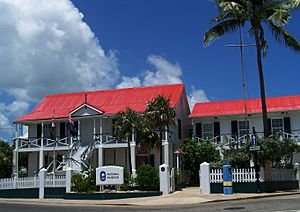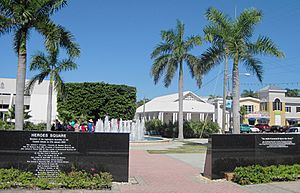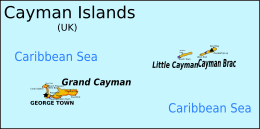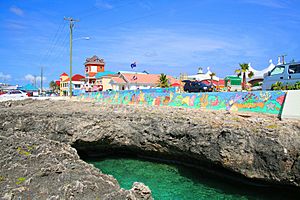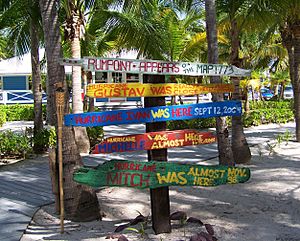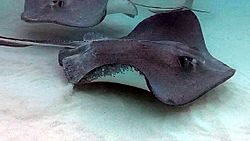Cayman Islands facts for kids
Quick facts for kids
Cayman Islands
Overseas territory of the United Kingdom |
|
|---|---|
|
|
|
|
Motto: "He hath founded it upon the seas"
|
|
|
Anthem: God Save the Queen (official)
National song: Beloved Isle Cayman |
|
 |
|
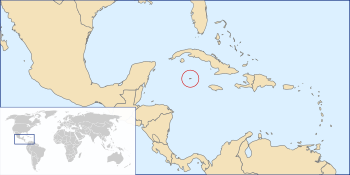 |
|
| Capital and largest city
|
George Town |
| Official languages | English |
| Ethnic groups
(2011)
|
|
| Demonym(s) | Caymanian |
| Government | British Overseas Territorya |
|
• Monarch
|
Elizabeth II |
|
• Governor
|
Duncan Taylor |
|
• Premier
|
Alden McLaughlin |
| Legislature | Legislative Assembly |
| Establishment | |
|
• British Overseas Territory
|
1962 |
|
• Current constitution
|
6 November 2009 |
| Area | |
|
• Total
|
264 km2 (102 sq mi) (206th) |
|
• Water (%)
|
1.6 |
| Population | |
|
• 2010 census
|
56,732 |
|
• Density
|
212/km2 (549.1/sq mi) (57th) |
| GDP (PPP) | 2008 estimate |
|
• Total
|
$2.335 billion |
|
• Per capita
|
$43,800 |
| GDP (nominal) | 2010 estimate |
|
• Total
|
$2.335 billion (158th) |
|
• Per capita
|
$47,000 |
| HDI (2008) | very high · 4th |
| Currency | Cayman Islands dollar (KYD) |
| Time zone | UTC-5 |
|
• Summer (DST)
|
UTC-5 (not observed) |
| Driving side | left |
| Calling code | +1-345 |
| ISO 3166 code | KY |
| Internet TLD | .ky |
The Cayman Islands are a group of islands in the western Caribbean Sea. They are a British Overseas Territory, meaning they are part of the United Kingdom but have their own government. The territory includes three main islands: Grand Cayman, Cayman Brac, and Little Cayman. These islands are located south of Cuba and northwest of Jamaica. The Cayman Islands are known as an important place for international business.
Contents
History of the Cayman Islands
Christopher Columbus first saw the Cayman Islands on May 10, 1503. This was during his fourth and last trip to the New World. He called them Las Tortugas because he saw many sea turtles there. The first English visitor was Sir Francis Drake in 1586. He later named the islands "Cayman" after the word for "alligator" used by the Neo-Taino people.
The Cayman Islands were mostly empty until the 1600s. There is no proof of native people living there before Europeans arrived. Instead, different kinds of settlers made the islands their home. These included pirates, people escaping the Spanish Inquisition, sailors whose ships had crashed, and soldiers who left Oliver Cromwell's army in Jamaica.
The first person known to live permanently on the Cayman Islands was Isaac Bodden. He was born on Grand Cayman around 1661. His grandfather was likely one of Oliver Cromwell's soldiers who took over Jamaica in 1655.
England officially took control of the Cayman Islands and Jamaica in 1670. This happened after the Treaty of Madrid. After some tries, a lasting English-speaking population began in the 1730s. As more people settled, they felt they needed slaves. Many slaves were brought from Africa. Today, most native Caymanians have both African and English family roots. The first census in 1802 showed that Grand Cayman had 933 people, and 545 of them were slaves. Slavery ended in the Cayman Islands in 1834. At that time, over 950 slaves were owned by 116 Caymanian families.
The islands were part of the Colony of Jamaica until 1962. Then, Jamaica became an independent country. The Cayman Islands became a separate Crown colony, still connected to the UK.
The Cayman Islands have historically been a place with very low taxes. On February 8, 1794, Caymanians helped rescue the crews of ten merchant ships. One of these ships carried Prince William, a son of King George III. This event is called the Wreck of the Ten Sail. A popular story says that King George III promised the islanders they would never have to pay taxes because of their kindness. However, this story is not true.
Even so, the Cayman Islands government has always used indirect taxes, not direct ones. The islands have never had income tax, capital gains tax, or any wealth tax. This makes them a popular place for businesses to register.
In September 2004, Hurricane Ivan hit Grand Cayman. The island is mostly flat and close to sea level. The storm caused a huge storm surge that flooded many areas. About 83% of homes on the island were damaged. Power, water, and phones were out for months in some places. Ivan was the worst hurricane to hit the islands in 86 years. Grand Cayman started rebuilding quickly. Within two years, most of its buildings and services were back to normal. Because of its location, the Cayman Islands are often affected by hurricanes. They are hit or brushed by a storm about every 2.23 years.
Geography of the Cayman Islands
The Cayman Islands are in the western Caribbean Sea. They are the tops of a huge underwater ridge called the Cayman Ridge. This ridge is next to the Cayman Trough, which is 6,000 m (20,000 ft) deep. The islands are about 700 km (430 mi) south of Miami, 366 km (227 mi) south of Cuba, and 500 km (310 mi) northwest of Jamaica. Grand Cayman is the largest island, covering 197 km2 (76 sq mi). The two "Sister Islands," Cayman Brac and Little Cayman, are about 120 km (75 mi) east-northeast of Grand Cayman. They are 38 and 28.5 km2 (14.7 and 11.0 sq mi) in size.
All three islands were formed by large coral heads on top of underwater peaks. They are mostly flat. The only major exception is The Bluff on Cayman Brac. It rises to 43 m (141 ft) above sea level, making it the highest point on the islands. The land is mostly limestone with coral reefs around it.
Animals of the Cayman Islands
The islands have some mammals, like the Central American agouti and eight kinds of bats. In the past, there were at least three types of native rodents that are now extinct. Many different kinds of whales and dolphins can be found in the waters offshore.
The Cayman Islands are home to special birds. These include two unique kinds of Amazona parrots. The Cayman Brac parrot lives only on Cayman Brac. The Grand Cayman parrot lives on the Cayman Islands, in Cuba, and on Isla de la Juventud. Little Cayman and Cayman Brac also have Red-footed and Brown Booby birds.
Another special animal is the endangered blue iguana. This iguana lives only on Grand Cayman.
Climate of the Cayman Islands
The Cayman Islands have a tropical marine climate. This means they have a wet season from May to October with warm, rainy summers. The dry season is from November to April, with cooler winters.
A big natural hazard for the islands is tropical cyclones. These storms form during the Atlantic hurricane season from June to November.
On September 11 and 12, 2004, Hurricane Ivan hit the Cayman Islands. The storm caused two deaths and a lot of damage to the islands' buildings and services. The total cost of the damage was about $3.4 billion.
People of the Cayman Islands
The Cayman Islands have more registered businesses than people. In mid-2011, the population was about 56,000. These people come from over 100 different countries. About half of the people are of Caymanian descent. Around 60% of the population has mixed racial backgrounds, mostly African and Caucasian. Most people on the islands are Christian, with many Presbyterians and Catholics. Most of the population lives on Grand Cayman, then Cayman Brac, and then Little Cayman. The population is expected to reach 60,000 by 2020.
The capital city of the Cayman Islands is George Town. It is located on the southwest coast of Grand Cayman.
Tourism in the Cayman Islands
One of the main attractions on Grand Cayman is Seven Mile Beach. Many hotels and resorts are located along this beach. It has been called one of the "Ultimate Beaches" by Caribbean Travel and Life magazine. Seven Mile Beach is on the western shore of Grand Cayman and is open to the public. You can walk the entire length of the beach, past all the hotels and public beach bars. Old places like Pedro St James Castle in Savannah also bring visitors. Tourists also visit the smaller "Sister Islands," Little Cayman and Cayman Brac.
All three islands are great for scuba diving. The Cayman Islands also have many places for snorkeling where you can swim with stingrays. The most popular place for this is Stingray City, Grand Cayman. Stingray City is a top attraction on Grand Cayman. It started in the 1980s when divers began feeding squid to the stingrays. The stingrays learned to connect the sound of boat engines with food, so they visit this area all year.
There are two shipwrecks off the shores of Cayman Brac, including the MV Captain Keith Tibbetts. Grand Cayman also has several shipwrecks, including one that was sunk on purpose. On January 5, 2011, the USS Kittiwake was sunk to create a new artificial reef near Seven Mile Beach. The Kittiwake has become a lively home for sea creatures. Visitors can see squirrelfish, rare sponges, Goliath groupers, and more. Both experienced and new divers can explore the Kittiwake.
Other fun places to visit on Grand Cayman include the unique rock formations of Hell. There's also Boatswain's Beach, a 23-acre (93,000 m2) marine theme park that is home to the Cayman Turtle Farm. You can also learn about how gourmet sea salt is made. The Mastic Trail is a hiking path through the forests in the middle of the island. The National Trust for the Cayman Islands offers guided tours of the Mastic Trail and other spots every week.
Another interesting place is the East End Light. This lighthouse is at the east end of Grand Cayman. It is part of the East End Lighthouse Park, managed by the National Trust for the Cayman Islands. It was the first lighthouse in the Cayman Islands.
Images for kids
See also
 In Spanish: Islas Caimán para niños
In Spanish: Islas Caimán para niños




